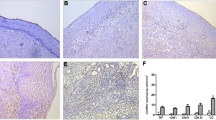Abstract
Objective
Data from the literature demonstrate that the local and systemic immune responses seem to play an important role in the progression of cervical intraepithelial neoplasia (CIN). Our aim was to investigate whether recurrences among CIN III patients might be related to the presence of local lymphocytes, macrophage and enzyme iNOS.
Methods
We analyzed 35 patients with CIN III who underwent conization and followed up for a minimum of 4 years. Using immunohistochemistry, the presence of T lymphocytes (CD3, CD8 and CD45RO), B lymphocytes (CD20), macrophages (CD68) and the expression of the enzyme iNOS were investigated. The quantity of marked cells is graded as: 0, absence of cells; 1, rare cells; 2, moderate number of cells; 3, many cells. For statistical purposes, we took the scores 0 and 1 to indicate weak marking and the scores 2 and 3 to indicate strong marking.
Results
We found strong positive expression of CD3-positive T lymphocytes among CIN III patients with recurrence following conization (100 vs. 50% without recurrence, p = 0.02). We did not find any statistical differences in the expression of CD20, CD68, CD45RO, CD8 or iNOS.
Conclusions
It is concluded that strong positive findings of CD3 T lymphocytes were related to recurrence following conization due to CIN III.

Similar content being viewed by others
References
Bais AG, Beckmann I, Lindemans J, Ewing PC, Meijer CJ, Snijders PJ, Helmerhorst TJ (2005) A shift to a peripheral Th2-type cytokine pattern during the carcinogenesis of cervical cancer becomes manifest in CIN III lesions. J Clin Pathol 58:1096–1100
BalkwilL F, Mantovani A (2001) Inflammation and cancer: back to Virchow? Lancet 357:539–545
Daniel D, Chiu C, Giraudo E, Inoue M, Mizzen LA, Chun R, Hanahan D (2005) CD4+ T cell-mediated antigen-specific immunotherapy in a mouse model of cervical cancer. Cancer Res 65:2018–2025
Demopoulos RI, Horowitz LE, Vamvakas EC (1991) Endocervical gland involvement by cervical intraepithelial neoplasia grade III: predictive value for residual and/or recurrent disease. Cancer 68:1932–1936
Feoli-Fonseca JC, Oligny LL, Brochu P, Simard P, Falconi S, Yotov WV (2001) Human papillomavirus (HPV) study of 691 pathological specimens from Quebec by PCR––direct sequencing approach. J Med Virol 63:284–292
Fernandes PC Jr, Garcia CB, Micheli DC, Cunha FQ, Murta EF, Tavares-Murta BM (2007) Circulating neutrophils may play a role in the host response in cervical cancer. Int J Gynecol Cancer 17:1068–1074
Fine JS, Byrnes HD, Zavodny PJ, Hipkin RW (2001) Evaluation of signal transduction pathways in chemoattractant-induced human monocyte chemotaxis. Inflammation 25:61–67
Georgiannos ST, Renaut A, Goode AW, Sheaff M (2003) The immunophenotype and activation status of the lymphocytic infiltrate in human breast cancers, the role of the major histocompatibility complex in cell-mediated immune mechanisms, and their association with prognostic indicators. Surgery 134:827–834
Hammes LS, Tekmal RR, Naud P, Edelweiss MI, Kirma N, Valente PT, Syrjanen KJ, Cunha-Filho JS (2007) Macrophages, inflammation and risk of cervical intraepithelial neoplasia (CIN) progression––clinicopathological correlation. Gynecol Oncol 105:157–165
Lee BN, Follen M, Shen DY, Malpica A, Adler-Storthz K, Shearer WT, Reuben JM (2004) Depressed type 1 cytokine synthesis by superantigen-activated CD4+ T cells of women with human papillomavirus-related high-grade squamous intraepithelial lesions. Clin Diagn Lab Immunol 11:239–244
Maluf PJ, Adad SJ, Murta EFC (2004) Outcome after conization for cervical intraepithelial neoplasia grade III: relation with surgical margins, extension to the crypts and mitoses. Tumori 90:473–477
Michelin MA, Murta EFC (2008) Potential therapeutic, vaccine strategies and relevance of immune system in uterine cervical cancer. Eur J Gynaecol Oncol 29:10–18
Miyara M, Sakaguchi S (2007) Natural regulatory T cells: mechanisms of suppression. Trends Mol Med 13:108–116
Monnier-Benoit S, Mauny F, Riethmuller D, Guemini JS, Capilna M, Felix S, Seilles E, Mougin C, Pretet JL (2006) Immunohistochemical analysis of CD4+ and CD8+ T-cell subsets in high risk human papillomavirus-associated pre-malignant lesions of the uterine cervix. Gynecol Oncol 102:22–31
Mourits MJE, Pieters WJ, Hollema H, Burger MP (1992) Three-group metaphase as a morphologic criterion of progressive cervical intraepithelial neoplasia. Am J Obstet Gynecol 167:591–595
Murta EFC, Resende AV, Souza MA, Adad SJ, Salum R (1999) Importance of surgical margins in conization for cervical intraepithelial neoplasia grade III. Arch Gynecol Obstet 263:42–44
Petter A, Heim K, Guger M, Ciresa-Ko Nig A, Christensen N, Sarcletti M, Wieland U, Pfister H, Zangerle R, Hopfi R (2000) Specific serum IgG, IgM and IgA antibodies to human papilomavirus types 6, 11, 16, 18 and 31 virus-like particles in human immunodeficiency virus-seropositive women. J Gen Virol 81:701–708
Pinzon-Charry A, Ho CS, Laherty R, Maxwell T, Walker D, Gardiner RA, O’Connor L, Pyke C, Schmidt C, Furnival C, Lopez JÁ (2005) Population of HLA-DR+ immature cells accumulates in the blood dendritic cell compartment of patients with different types of cancer. Neoplasia 7:1112–1122
Terra APS, Murta EFC, Maluf PM, Caballero OLSD, Brait M, Adad SJ (2007) Aberrant promoter methylation can be useful as a marker of recurrent disease in patients with cervical intraepithelial neoplasia grade III. Tumori 93:572–579
Acknowledgments
We thank FAPEMIG, FINEP and CNPq for funding.
Author information
Authors and Affiliations
Corresponding author
Rights and permissions
About this article
Cite this article
Maluf, P.J., Michelin, M.A., Etchebehere, R.M. et al. T lymphocytes (CD3) may participate in the recurrence of cervical intraepithelial neoplasia grade III. Arch Gynecol Obstet 278, 525–530 (2008). https://doi.org/10.1007/s00404-008-0621-8
Received:
Accepted:
Published:
Issue Date:
DOI: https://doi.org/10.1007/s00404-008-0621-8




